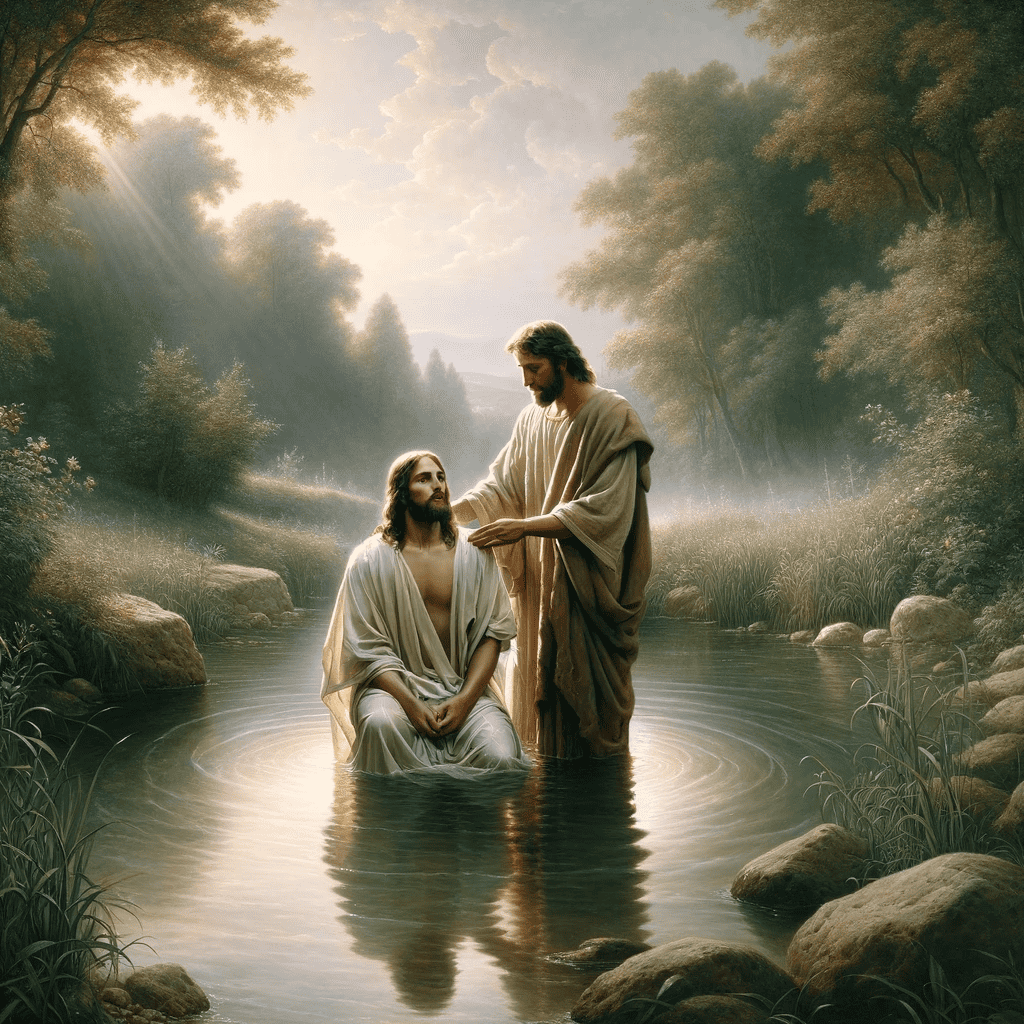
The Symbolic Encounter: John the Baptist and Jesus in the Jordan River
In the wilderness of Judea, amidst a backdrop of arid landscapes and the flowing Jordan River, an extraordinary story unfolds—a story that has captivated believers, scholars, and seekers of spiritual truth for centuries. This narrative, rooted in the heart of Christian tradition, is found in the Gospel of Matthew, specifically in Matthew 3:1-17. It’s a tale of two pivotal figures in Christianity: John the Baptist and Jesus Christ. Their meeting marks a momentous occasion, symbolizing a turning point in religious history and offering profound insights into the themes of repentance, baptism, and divine affirmation.
The Voice in the Wilderness
John the Baptist emerges as a compelling figure, an ascetic prophet clothed in camel’s hair, with a leather belt around his waist, surviving on locusts and wild honey. He is the voice crying out in the wilderness, urging the people of Judea and Jerusalem to repent, for the kingdom of heaven is near. John’s message is clear and potent, calling for a baptism of repentance for the forgiveness of sins. People from all walks of life flock to him, confessing their sins and being baptized in the Jordan River. Yet, John is aware of his place in the grand scheme of things. He speaks of one who is coming after him, someone greater, whose sandals he is not worthy to carry. This person, John prophesies, will baptize not with water but with the Holy Spirit and fire.
The Baptism of Jesus
Then comes a moment of profound humility and transcendence. Jesus, from Galilee, approaches John at the Jordan, seeking baptism. John, recognizing Jesus, hesitates, saying, “I need to be baptized by you, and do you come to me?” But Jesus insists, stating it is proper to fulfill all righteousness. Thus, John consents, and Jesus is baptized. As He rises from the water, the heavens open, and the Spirit of God descends like a dove, lighting upon Him. A voice from heaven declares, “This is my Son, whom I love; with him, I am well pleased.”
Insights and Reflections
This encounter between John the Baptist and Jesus is rich with symbolic and theological significance. It represents the humility and obedience of Jesus, the fulfillment of God’s righteousness, and the inauguration of His public ministry. The baptism of Jesus by John also signifies the passing of the old to the new, from the baptism of repentance to the baptism of the Holy Spirit. The divine affirmation of Jesus as God’s beloved Son echoes the deep, unconditional love God extends to humanity.
For believers and spiritual seekers, this story offers a template for transformation and new beginnings. It invites introspection on the nature of repentance, the willingness to embrace change, and the open-hearted acceptance of divine guidance and affirmation. The baptism of Jesus marks not only the start of His mission but also a call to all who would follow Him to embark on their own journey of faith, renewal, and commitment to living out the values of the kingdom of heaven.
The symbolic encounter at the Jordan River, between John the Baptist and Jesus, remains a foundational event within Christian tradition. It encapsulates themes of preparation, revelation, and the unfolding of God’s redemptive plan. As we reflect on this story, we are reminded of the enduring power of faith, the importance of humility, and the transformative promise of divine love and acceptance.
Summary of Matthew 3:1-17: The Baptism of Jesus by John the Baptist
Matthew 3:1-17 recounts a pivotal moment in the New Testament, highlighting the emergence of John the Baptist and the baptism of Jesus Christ, which marks the beginning of Jesus’ public ministry. Here’s a concise summary of the events as they unfold in this passage:
- John the Baptist’s Ministry (Verses 1-6): John the Baptist appears in the wilderness of Judea, preaching a message of repentance for the forgiveness of sins, in anticipation of the coming kingdom of heaven. His appearance and diet are austere, signifying his role as a prophet. People from Jerusalem, Judea, and the region around the Jordan come to him, confess their sins, and are baptized in the Jordan River.
- John’s Message to the Pharisees and Sadducees (Verses 7-12): When many Pharisees and Sadducees come for baptism, John rebukes them, calling them a “brood of vipers” and challenging them to show evidence of repentance. He emphasizes that lineage to Abraham is not enough for salvation and warns of the coming judgment. John also speaks of one who is coming after him, who is greater than he, who will baptize with the Holy Spirit and fire.
- The Baptism of Jesus (Verses 13-17): Jesus comes from Galilee to the Jordan to be baptized by John. Initially, John hesitates, recognizing Jesus’ superiority, but Jesus insists, saying it is necessary to fulfill all righteousness. After Jesus is baptized, as He comes up from the water, the heavens open, and the Spirit of God descends like a dove and alights on Him. A voice from heaven declares, “This is my Son, whom I love; with him, I am well pleased.”
This passage is significant for its themes of repentance, the fulfillment of prophetic ministry, and the divine affirmation of Jesus as the Son of God. It marks a transition from the Old Covenant to the New, symbolized by the baptism of Jesus, and sets the stage for His mission and ministry on earth.